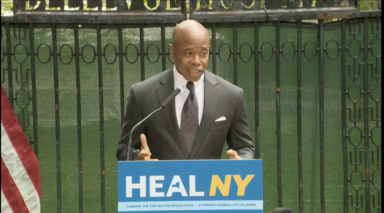Mayor announces $256 million in funds for opioid addiction treatment, prevention

State Attorney General Letitia James and Mayor Eric Adams Thursday announced the city will receive $88.9 million this year to fight the opioid crisis in the city, following a $1.5 billion settlement between James’ office and opioid manufacturers and distributors.
The $88.9 million the city is getting this year is the first round of up to $256 million it could receive in restricted funds for opioid treatment, education and prevention over the next couple of years.
James said the settlement was the result of a hard-fought legal battle between her office and major pharmaceutical companies including AmerisourceBergen Corp., Cardinal Health Inc. and McKesson Corp. over the ongoing epidemic of opioid overdoses throughout New York city and state as well as across the country.
“Pharmaceutical companies that flooded New York communities with opioids are finally paying for the harm and devastation they caused,” James said. “For far too long, opioid makers and distributors created more pain and suffering than they claimed to cure. The settlements my office secured from these companies are a result of our unwavering commitment to hold the powerful accountable and protect New Yorkers. Mayor Adams has been a dedicated partner in this fight, and we will not rest until our communities are free from the scourge of opioids. The money distributed today will help us turn the tide on the opioid crisis and ensure that every New Yorker struggling with addiction gets the help they need.”
James and Adams announced the funding outside the gate to NYC Health and Hospitals Bellevue joined by city Department of Health and Mental Hygiene (DOHMH) Commissioner Dr. Ashwin Vasan, chief medical officer of NYC Health and Hospitals Dr. Machelle Allen and Manhattan Borough President Mark Levine.
For Adams, securing this funding is personal. The mayor said several of his friends have struggled with opioid addiction.
“One I can think of, who had knee surgery, three years later he was still taking painkillers,” Adams said. “Think about that. And you’re almost hooked on drugs.”
Adams said it’s time to shift blame for the opioid epidemic from people struggling with addiction on street corners to those who are actually responsible for the crisis.
“It’s time to look at the three-piece suit pharmaceutical industries are those who are the distributors of drugs,” Adams said. “An illegal way into households, giving children prescriptions, over prescribing. And the Attorney General zeroed in on that, and just did her job. And brought the money that’s needed to complement the services that we need to really push back on this overdose crisis.”
DOHMH recently released data that showed the city experienced a record number of overdose deaths last year, according to a release. During the first six months of 2021 1,233 died from opioid overdoses compared to 965 during the same period in 2020.
Vasan said another New Yorker dies from an overdose every four hours.
“Just let that sink in for a minute,” Vasan said. “From the time you woke up, maybe got to your desk, had a cup of coffee until now, we’ve lost a New Yorker due to overdose. This means every four hours we’re losing loved ones, family members, neighbors, thousands of New Yorkers, record number dying of overdose.”
While the city controls where the funds will actually be used, James said she hopes they’re put towards more opioid treatment center beds throughout the city. Rebecca Linn-Walton, the senior assistant vice president in the Office of Behavioral Health at NYC Health and Hospitals, said the city already has a number of plans for how to use the funds.
“We have substance use peer counselors that have been essential throughout the whole crisis in our hospitals,” Linn-Walton said. “Those are people with lived experience. We’re looking at expanding our teams in the emergency department, inpatient medicine. We want to have behavioral health right then and there in primary care and women’s health and obstetrics and gynecology. We really want to meet patients wherever they’re going to disclose what’s going on because they have a relationship with doctors.”





